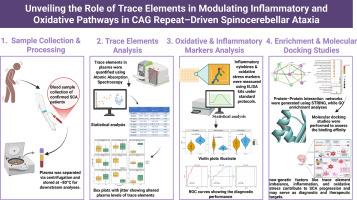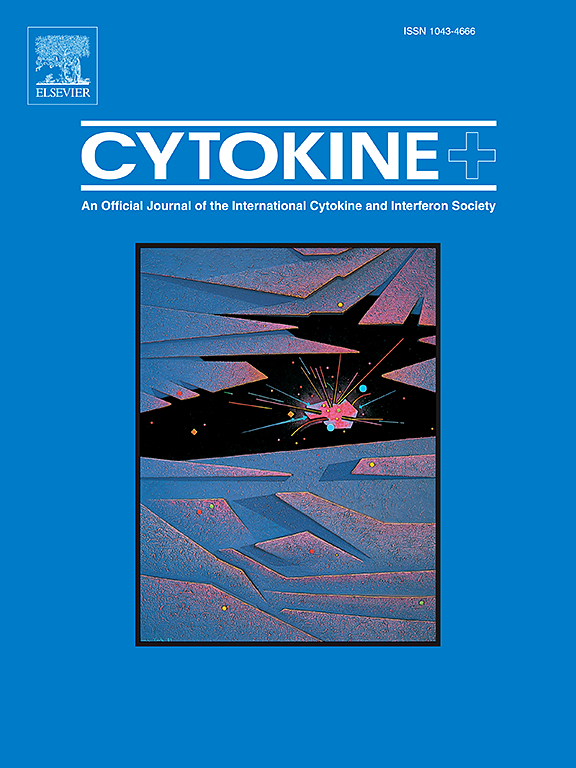揭示微量元素在CAG重复驱动的脊髓小脑性共济失调中调节炎症和氧化途径的作用。
IF 3.7
3区 医学
Q2 BIOCHEMISTRY & MOLECULAR BIOLOGY
引用次数: 0
摘要
脊髓小脑共济失调是一种遗传性神经退行性疾病,主要由CAG三核苷酸重复扩增引起。虽然这些基因突变引发了疾病的发生,但越来越多的证据表明,系统性因素,特别是微量元素失衡、氧化应激和免疫失调,在疾病进展中起着关键作用。在这项研究中,我们分析了基因证实的SCA患者(n = 15)和年龄和性别匹配的健康对照(n = 18)的外周血样本。原子吸收光谱显示血浆中必需和有毒微量元素浓度的显著变化,表明它们参与神经毒性、氧化还原失衡和炎症。为了探索这些联系,氧化应激标志物,包括丙二醛、超氧化物歧化酶和谷胱甘肽过氧化物酶,以及细胞因子,如白细胞介素-6、白细胞介素-4和白细胞介素-10,使用ELISA进行定量。受试者工作特征分析表明,这些标记具有较高的诊断准确性,特别是GPx和IL-10。微量元素失调、氧化应激和炎症反应之间存在密切联系,表明它们在加剧神经变性方面具有协同作用。分子对接揭示了异常微量元素水平可能通过破坏金属结合相互作用而损害抗氧化酶的功能,为酶功能障碍提供了机制见解。生物信息学分析,包括功能富集和蛋白-蛋白相互作用定位,确定了与线粒体功能障碍、活性氧代谢和细胞因子信号通路的显著关联。这些发现表明SCA的发病机制并非仅由基因突变驱动。微量元素失衡、氧化应激和炎症的综合作用形成了一个复杂的致病网络,这加强了在治疗策略中针对遗传和全身因素的重要性。本文章由计算机程序翻译,如有差异,请以英文原文为准。

Unveiling the role of trace elements in modulating inflammatory and oxidative pathways in CAG repeat–driven spinocerebellar ataxia
Spinocerebellar ataxias are genetically inherited neurodegenerative disorders, primarily caused by CAG trinucleotide repeat expansions in genes. While these genetic mutations initiate disease onset, increasing evidence suggests that systemic factors, particularly trace element imbalance, oxidative stress, and immune dysregulation, play critical roles in disease progression. In this study, peripheral blood samples from genetically confirmed SCA patients (n = 15) and age- and sex-matched healthy controls (n = 18) were analyzed. Atomic Absorption Spectroscopy revealed significant alterations in plasma concentrations of both essential and toxic trace elements, suggesting their involvement in neurotoxicity, redox imbalance, and inflammation. To explore these links, oxidative stress markers, including malondialdehyde, superoxide dismutase, and glutathione peroxidase, as well as cytokines such as interleukin-6, interleukin-4, and interleukin-10, were quantified using ELISA. Receiver operating characteristic analysis demonstrated high diagnostic accuracy of these markers, particularly GPx and IL-10. A strong interconnection was observed among trace element dysregulation, oxidative stress, and inflammatory responses, indicating a synergistic role in exacerbating neurodegeneration. Molecular docking revealed that abnormal trace element levels may impair antioxidant enzyme function by disrupting metal-binding interactions, offering mechanistic insight into enzymatic dysfunction. Bioinformatics analyses, including functional enrichment and protein–protein interaction mapping, identified significant associations with mitochondrial dysfunction, reactive oxygen species metabolism, and cytokine signaling pathways. These findings suggest that SCA pathogenesis is not driven by genetic mutation alone. The combined effects of trace element imbalance, oxidative stress, and inflammation contribute to a complex pathogenic network, reinforcing the importance of targeting both genetic and systemic factors in therapeutic strategies.
求助全文
通过发布文献求助,成功后即可免费获取论文全文。
去求助
来源期刊

Cytokine
医学-免疫学
CiteScore
7.60
自引率
2.60%
发文量
262
审稿时长
48 days
期刊介绍:
The journal Cytokine has an open access mirror journal Cytokine: X, sharing the same aims and scope, editorial team, submission system and rigorous peer review.
* Devoted exclusively to the study of the molecular biology, genetics, biochemistry, immunology, genome-wide association studies, pathobiology, diagnostic and clinical applications of all known interleukins, hematopoietic factors, growth factors, cytotoxins, interferons, new cytokines, and chemokines, Cytokine provides comprehensive coverage of cytokines and their mechanisms of actions, 12 times a year by publishing original high quality refereed scientific papers from prominent investigators in both the academic and industrial sectors.
We will publish 3 major types of manuscripts:
1) Original manuscripts describing research results.
2) Basic and clinical reviews describing cytokine actions and regulation.
3) Short commentaries/perspectives on recently published aspects of cytokines, pathogenesis and clinical results.
 求助内容:
求助内容: 应助结果提醒方式:
应助结果提醒方式:


